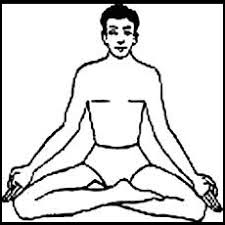SWASTIKASANA (Auspicious Pose) in Hath Yoga
SWASTIKASANA (Auspicious Pose)
a straight body. This is called swastika (asana) (19).
Swastikasana is a yoga pose based on the name and qualities of the symbol swastika. Swastik marks have been important since ancient days and have been found in houses and painted on weapons. Swastikasana is an auspicious pose yoga. The term Swastikasana has 3 root words, Su, Asti & Ka. ‘Su‘ means good’; ‘Asti‘ means ‘exist’; ‘ka‘ means ‘to make’. On combining the root terms, Swatikasana can be defined as a pose that makes one exist in a good state of mind. It is one of the best postures for meditating. It plays an essential role in regulating the body and the mind.
Technique of Swastikasana
Sit cross-legged and bring the feet up between the thighs and calf muscles. Place the hands in jnana or chin mudra.
Though this is a steady sitting position, it affects the whole body. Prana shakti is directed in a particular manner suitable for meditation. The nadi sat the back of the legs are stimulated. The exact points of stimulation can be found by pressing along the acupuncture meridians. When you find a particularly tender and sensitive point, that is a center. These nadis carryenergy to centers in the spinal column and the energy is distributed fromthere. When you sit in any meditative pose you are stimulating the mainnadis.
The sciatic nerve is gently massaged in this posture, thereby influencing the lumbar region. The abdominal muscles are also influenced and the inner body temperature is affected. Swatmarama does not forget to state that the body should be straight, i.e. in alignment. This is of prime importance in any asana practice. For meditation it is essential that the spinal column is straight so that nervous impulses can pass freely to the brain.
Furthermore, the main nadi, sushumna, is situated within the spinal cord and the impulses must also be able to run straight up this nadi when the energy wants torise. If you bend or lean to one side, either ida or pingala will be suppressed and the other will become predominant. The aim is to activate sushumna, therefore, the body must be in alignment and in a balanced position so there is no blockage to the flow of prana.
The symbol of the swastika represents fertility, creativity and auspiciousness. Thus this asana, being so named, induces the same capacity in the body
Meditation pose: Swatikasana is a good meditation pose. Especially for people who find it difficult to sit in, more classical poses like Padmasana and Siddhasana.
Stretches the lower body: The hamstrings and glutes are stretches. This is a great stretch for runners.
Spinal alignment: The spine is stretched which strengthens the back.
Optimal organ functioning: As the torso is stretched, all the organs have the optimal place to function efficiently.
Benefits of Swastikasana
Stimulates calmness: As our eyes are focused on the Trikuti (third eyes), calmness and clarity are induced.


Comments
Post a Comment